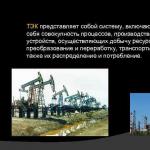Warehouse costs. Disagreements regarding the determination of procurement and storage costs for equipment. The main goal of OS Atoll-Pharm is to make a profit
Warehouse costs are costs associated with ensuring the safety of products. Storage costs are additional costs caused by the continuation of the production process in the sphere of circulation, i.e. they are productive in nature. However, they will be productive costs only when storing the standard volume of product inventories necessary to ensure the continuity of the logistics process.
The main cost items for maintaining warehouses can be grouped as follows:
- · 1. Maintenance of warehouse premises:
- - depreciation of warehouse buildings;
- - depreciation of warehouse equipment;
- - costs of preventive repairs;
- - costs for heating, electricity and water;
- - building insurance and land tax;
- - rent.
- · 2. Costs for service personnel:
- - wages of warehouse workers and employees;
- - expenses for social needs of workers and employees.
- · 3. Vehicle costs:
- - depreciation;
- - fuel and energy costs;
- - expenses for preventive and current repairs;
- - insurance and taxes on vehicles.
- · 4. Losses from storage of inventories:
- - protection of warehouses and aging of materials;
- - corrosion and other losses;
- - discrepancies in inventory results (errors in accounting for release and acceptance);
- - theft;
- - losses due to price decreases;
- - inventory insurance.
Western economists also include interest losses on capital, which could be obtained if it were not necessary to withdraw money from bank accounts to finance the construction of warehouses and equipping them with appropriate equipment.
The listed cost items can reach significant amounts, so the logistics system is constantly being optimized from the point of view of searching for operating mechanisms that would reduce the need for warehouses to the required minimum, simplify the procedure for ordering and receiving supplies, and speed up the system's performance.
- 1) determination of the optimal number of storage stages;
- 2) determining the optimal number of warehouses at each stage;
- 3) determining the location of warehouses that ensures minimum total costs;
- 4) finding a rational distribution of delivery locations.
List of costs required to operate a warehouse:
- 1) costs of planning the workload and work of warehouse personnel;
- 2) costs for commissioning and testing;
- 3) annual costs for interwarehouse movements;
- 4) cash expenses written off as expenses;
- 5) costs for the necessary initial inventories of products.
The following indicators of the efficiency of warehouse use are calculated:
- 1) wholesale and warehouse turnover - the main indicator characterizing the operation of a warehouse for a certain period of time (month, quarter, year);
- 2) warehouse turnover - the number of goods (in tons) received at the warehouse and released from the warehouse for a certain period;
- 3) specific wholesale and warehouse turnover - shows the wholesale and warehouse turnover per 1 m2 of usable warehouse area;
- 4) coefficient of utilization of the useful area of the warehouse - the ratio of the area occupied for storing goods to the total area of the warehouse;
- 5) warehouse throughput - shows how many goods can be processed in the warehouse per unit of time;
- 6) the cost of processing 1 ton of goods - the ratio of the total annual operating costs to the warehouse turnover. The total amount of annual operating costs for wages of warehouse workers, costs of storage, acceptance, dispatch of goods, costs of maintaining warehouse premises and low-value inventory, amounts of commodity losses, etc.;
- 7) labor productivity of warehouse workers - determined by the ratio of the warehouse’s annual cargo turnover to the average number of workers for a given period of time;
- 8) level of mechanization of work - is defined as the ratio of the volume of work performed using machines to the total volume of work;
- 9) specific capital investments - the ratio of one-time capital costs to warehouse turnover;
- 10) payback period of capital investments - the ratio of one-time capital investments to the annual amount of profit;
- 11) coefficient of efficiency of use of capital investments - shows what part of the investments is reimbursed annually at the expense of profits and is calculated as the amount of profit for the period in addition to one-time investments.
Warehouse costs are determined by the amount of costs for organizing the storage of products and the amount of overhead costs.
Objectives of minimizing warehouse costs:
- - determination of the optimal number of storage stages;
- - determination of the optimal number of warehouses at each stage;
- - determining the location of warehouses that ensures minimum total costs;
- - finding a rational distribution of delivery locations.
The costs required to operate warehouses include: costs for planning the workload and work of warehouse personnel; expenses for putting the warehouse into operation and testing it; annual costs for interwarehouse movements; cash expenses written off as expenses; costs for the necessary initial inventories of products.
Warehouse income is determined based on the current fee rates established by type of product per ton-day of storage.
The cost of processing one ton of products in a warehouse is a synthetic indicator that characterizes the total cost of living and material labor in a warehouse. This indicator indicates the effectiveness of the technological process used in the warehouse.
The cost of storing products is determined by the ratio of the total costs associated with performing warehouse operations to the number of ton-days of storage.
The payback period of a warehouse is the ratio of the amount of one-time investment to the annual amount of profit.
Procurement and storage costs
When drawing up local estimates, the question increasingly arises about the need to apply procurement and storage costs to materials and equipment. Let's figure out what they already take into account and to what extent they should be taken into account.
MDS 81-35.2004 states:
4.64. Procurement and warehouse costs include costs associated with placing purchase orders, acceptance, accounting, storage of equipment in a warehouse, inspection and preparation of it for installation, as well as transferring it for installation. They are taken into account as part of the estimated cost of equipment. The amount of procurement and storage costs can be determined by a separate calculation.
Excerpt from the Methodology for applying estimated prices of construction resources (Approved by order of the Ministry of Construction and Housing and Communal Services of the Russian Federation dated 02/08/2017 77/pr):
6.4.5. The cost of material resources, taking into account the costs of delivery to the on-site warehouse, is determined in accordance with the formula Z = ((STs x ZSR + T1) + (STs x ZSR + T2))/ 2 (It is worth noting that the estimated price of the material is multiplied by the percentage of procurement -warehouse costs (1.02; 1.0075; 1.015)),
where: Z – cost of the material resource, rub.;
SP - estimated price of a construction resource - consolidated, territorially aggregated documented information on the cost of construction resources, established by calculation for the accepted unit of measurement and published in the Federal State Information System of Pricing in Construction, rubles;
ZSR – procurement and storage costs, rub.
The ZSR indicator is differentiated by the following types of material resources:
building materials (except for metal structures) - 2%;
metal building structures - 0.75%;
equipment - 1.5.
MDS 81-36.2004 states:
1.7. The FER takes into account:
- estimated prices for building materials, products and structures - according to the Federal Collection of Estimated Prices for materials, products and structures used in construction (include average prevailing selling prices and transport costs in the amount of up to 13% of selling prices, taking into account delivery from the manufacturer's ex-warehouse to the ex-office warehouse for the construction of the facility, including procurement and storage costs and the costs of intermediaries in the sphere of circulation);
General information:
Ex-warehouse is a condition of the transaction, according to which the supplier is obliged to deliver the goods to the point specified in the contract. Before the buyer receives the goods, all shipping costs are borne by the seller.

But since the pricing system is being reformed, some of the methodological recommendations have been cancelled, for example the well-known MDS 81-36.2004.
Let's take a closer look:
The estimated cost of materials used in construction is determined at the basic price level - according to collections (catalogs) of estimated prices for materials, products and structures - federal, territorial (regional) and industry, and at the current price level - at the actual cost of materials, products and structures, taking into account transport and procurement and storage costs, markups (surcharges), commissions paid to supply foreign economic organizations, payment for services of commodity exchanges, including brokerage services, customs duties (clause 4.24 MDS 81-35.2004).
At the moment, with the release of the GESN and FER database in 2017, in the methodological recommendations for the use of material resources, clause 6.4 states that when drawing up estimate documentation, the costs of material resources are determined on the basis of the estimated prices of construction resources, prices of services, taking into account procurement and warehouse expenses, and in the Methodology for determining estimated prices for materials, products, structures, equipment and prices of services for the transportation of goods for construction, clause 4.13 - Estimated prices formed in the manner provided for in this section do not take into account transportation costs for the delivery of material resources from manufacturers (suppliers) ) to the on-site warehouse of the construction site and procurement and storage costs. Transport and procurement and storage costs are determined when drawing up estimate documentation in the manner established in the Methodology for the Application of Estimated Prices of Construction Resources, referring us to the methodology and the MDS.
Thus, when calculating procurement and storage costs, we use methodological recommendations for the use of material resources and MDS. If any controversial issues arise, you can also ask us a question by email: or call us, or also ask a question in the chat to a specialist.
The article was updated based on the results of customer requests (letters, chat) in October 2019.
Joannes Vermorel, December 2016
Inventory costs are the costs associated with storing and replenishing inventory over a period of time. Inventory costs are typically expressed as a percentage of total inventory value (average for the year; e.g., for retail, the average quantity purchased from suppliers per year) for every year. This figure varies greatly depending on the field of activity, but it is always quite high. It is generally accepted that Carrying costs alone account for about 25% of the total value of inventory on hand.
Thus, it is quite difficult to give a clear definition. Warehousing costs, total inventory management costs (ITC), inventory holding costs, ...: the terms associated with "warehouse costs" can be quite confusing, and what they mean varies only slightly depending on the source and industry. companies. In this article, we focus on the costs of “static” inventories, rather than the costs of handling goods. More precisely, we put aside issues related to the flow of goods and consider exclusively the costs of storing a certain amount of goods. We also look at these issues from the perspective of business organizations.
For retailers, wholesalers, and most online sellers, inventory is typically their largest asset and largest expense. That is why assessing the costs of storing goods is so important, affecting the financial activities and management of the company. It helps companies determine how they can benefit from inventory, how they can cut costs, where they can make changes, which suppliers or products to choose, how to allocate capital, and so on.
List of sources
1. Mary Lu Harding, C.P.M., CPIM, CIRM, “Calculating the total cost of ownership for items which are inventoried,” NPMA, volume 14, issue 2, 2002.2. Christopher S. Jones and Selale Tuzel, “Inventory Investment and the Cost of Capital,” January 2009, available online. 3. Helen Richardson, “Control your costs then cut them,” Transportation & Distribution, December 1995, 94-96.
4. Edward A. Silver, David F. Pyke, Rein Peterson, Inventory Management and Production Planning and Scheduling, 3r edition, John Wiley & Sons, 1998.
5. Stephen G. Timme and Christine Williams-Timme, “The Real Cost of Holding Inventory,” Supply Chain Management Review, 7/1/2003.
Storage costs– costs associated with ensuring the safety of products. Storage costs are additional costs caused by the continuation of the production process in the sphere of circulation, i.e. they are productive in nature. However, they will be productive costs only when storing the standard volume of product inventories necessary to ensure the continuity of the logistics process. Storage costs include:
1) costs of maintaining warehouses;
2) wages of warehouse personnel;
3) shortage of products within the limits of natural loss;
4) administrative, management and other expenses. Warehouse costs are determined by the amount of costs for organizing the storage of products and the amount of overhead costs.
Objectives of minimizing warehouse costs:
1) determination of the optimal number of storage stages;
2) determining the optimal number of warehouses at each stage;
3) determining the location of warehouses that ensures minimum total costs;
4) finding a rational distribution of delivery locations.
List of costs required to operate a warehouse:
1) costs of planning the workload and work of warehouse personnel;
2) costs for commissioning and testing;
3) annual costs for interwarehouse movements;
4) cash expenses written off as expenses;
5) costs for the necessary initial stocks of pro-C production.
The following indicators of the efficiency of warehouse use are calculated:
1) wholesale and warehouse turnover - the main indicator characterizing the operation of a warehouse for a certain period of time (month, quarter, year);
2) warehouse turnover - the number of goods (in tons) received at the warehouse and released from the warehouse for a certain period;
3) specific wholesale and warehouse turnover - shows the wholesale and warehouse turnover per 1 m2 of usable warehouse area;
4) coefficient of utilization of the useful area of the warehouse - the ratio of the area occupied for storing goods to the total area of the warehouse;
5) warehouse throughput - shows how many goods can be processed in the warehouse per unit of time;
6) the cost of processing 1 ton of goods - the ratio of the total annual operating costs to the warehouse turnover. The total amount of annual operating costs for wages of warehouse workers, costs of storage, acceptance, dispatch of goods, costs of maintaining warehouse premises and low-value inventory, amounts of commodity losses, etc.;
7) labor productivity of warehouse workers - determined by the ratio of the annual cargo turnover of the warehouse to the average number of workers for a given period of time;
8) level of mechanization of work - is defined as the ratio of the volume of work performed using machines to the total volume of work;
9) specific capital investments - the ratio of one-time capital costs to warehouse turnover;
10) payback period of capital investments - the ratio of one-time capital investments to the annual amount of profit;
11) coefficient of efficiency of use of capital investments - shows what part of the capital investments is reimbursed annually from profits and is calculated as the amount of profit for the period in addition to one-time capital investments.
The design organization, on the instructions of the Customer (budget construction), draws up design documentation for the construction of an industrial facility according to the 2017 estimate and regulatory framework and using new Methods. Disagreements arose regarding the determination of procurement and storage costs for equipment.
We applied 1.5%, and the Customer requires 1.2%, as was before. Which one of us is right?
Answer
Please note that previously, according to clause 3.3.1. and 3.3.12 “Guidelines for the development of collections (catalogues) of estimated prices for materials, products, structures and collections of estimated prices for the transportation of goods for the construction and major repairs of buildings and structures” - (and clauses 4.24. and 4.64.), procurement -warehouse costs were taken as a percentage of the cost of materials, products and structures, as well as equipment, taking into account transportation costs (ex-vehicle at the on-site warehouse of the construction site), since the estimated price for materials was formed from the following elements:
- selling price (including containers, packaging and props);
- markups (surcharges) of supply and sales organizations;
- customs duties and fees (when received from abroad);
- the cost of transportation and loading and unloading work (as a rule, the cost of loading work is taken into account directly in the selling price, and the cost of unloading work is included in the unit prices for construction, installation and repair work);
- procurement and storage costs, including kitting costs.
The amounts of procurement and storage costs were determined in clause 3.3.12:
"3.3.12. Procurement and storage costs are determined on the basis of calculations based on the conditions prevailing in the region. For construction projects financed from the federal budget, they are accepted according to SNiP 4-91 standards as a percentage of the cost of materials, including:
- for building materials, products and structures (except for metal structures) - 2%;
- for metal building structures - 0.75%;
- for equipment - 1.2%.
Currently, by order of the Ministry of Construction dated December 20, 2016 No., the “Methodology for determining estimated prices for materials, products, structures, equipment and prices of services for the transportation of goods for construction” has been approved. The approved Methodology does not directly indicate which existing Methodology it is being introduced to replace, but it can be assumed that instead.
In pp. 4.1 and 4.13 of the Methodology, the concept of “estimated” price and definition of procurement and storage costs has been changed:
"4.1. Selling prices (sales prices) of domestically produced material resources include the cost of containers, packaging and props (if any), the cost of a set of spare parts for the warranty period (for equipment), and the cost of loading products onto vehicles at the manufacturer's warehouse.
4.13. Estimated prices formed in the manner prescribed by this section do not take into account transportation costs for the delivery of material resources from manufacturers (suppliers) to the on-site warehouse of the construction site and procurement and storage costs. Transport and procurement and storage costs are determined when drawing up estimate documentation in the manner established in the Methodology for the Application of Estimated Prices of Construction Resources.”
More specifically about accounting for transportation costs and procurement and storage costs stated in clause 6.4.5 “Methods for applying estimated prices of construction resources”, approved by order of the Ministry of Construction dated 02/08/2017 No.:
"6.4.5. The cost of material resources, taking into account the costs of delivery to the on-site warehouse, is determined in accordance with formula (6.1):
Z = (SC * ZSR + T1) + (SC * ZSR + T2) / 2
where: 3 - cost of material resource, rub.;
SP - estimated price of a construction resource - consolidated, territorially aggregated documented information on the cost of construction resources, established by calculation for the accepted unit of measurement and published in the Federal State Information System of Pricing in Construction, rubles;
T1, T2 - cost of transportation of material resources, rub.;
ZSR - procurement and storage costs, rub*.
The ZSR indicator is differentiated by the following types of material resources:
- building materials (except for metal structures) - 2%;
- metal building structures - 0.75%;
- equipment -1.5%.
Thus, procurement and storage costs according to the given formula are charged on the estimated (or rather, on the selling) price of materials. Until now, the Ministry of Construction has refused to make changes to the procedure for calculating procurement and storage costs.
Glavgosexpertiza, in its letter dated October 24, 2017 No. 01-01-17/7342-IL (given below), reported that 1.5% is a typo (i.e. the amount of procurement and storage costs for equipment should be the same as before - 1.2% according to clause 4.64 or clause 3.3.12).
LETTER
Federal Autonomous Institution "Main Directorate of State Expertise" (FAU "Glavgosexpertiza of Russia")
dated October 24, 2017 No. 01-01-17/7342-IL
FAU "Glavgosexpertiza of Russia" reports the following.
When drawing up estimate documentation using federal estimated prices for materials, products, structures and equipment used in construction FSSC 81-01-2001, you should be guided by the general provisions for them.
According to paragraph 5 of the General Provisions of the FSSC 81-01-2001, procurement and warehouse costs are accepted as a percentage of the cost of materials, products, structures and equipment ex-office warehouse in the amount of:
- for building materials, products and structures (except for metal building structures) - 2%;
- for metal building structures - 0.75%;
- for equipment - 1.2%.
The provisions of the Methodology for the Application of Estimated Prices of Construction Resources (hereinafter referred to as the Methodology), approved by Order No. of the Ministry of Construction of Russia dated 02/08/2017, apply to estimated prices determined in accordance with:
- Methodology for determining estimated prices for labor costs, approved by order of the Ministry of Construction of Russia dated December 20, 2016 No.;
- Methodology for determining estimated prices for the operation of machines and mechanisms, approved by order of the Ministry of Construction of Russia dated December 20, 2016 No.;
- The method of estimated prices for materials, products, structures, equipment and prices of services for the transportation of goods for construction, capital construction projects, approved by order of the Ministry of Construction of Russia dated December 20, 2016 No.
First Deputy
Head of the Pricing Establishment
I.N. Lishchenko
* Must be %, not rubles (editor's note).





